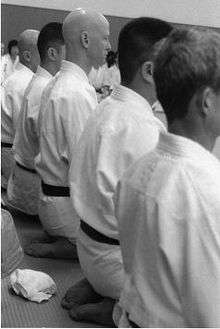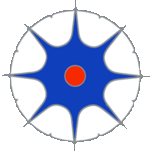Shodokan Aikido
|
The Shodokan Aikido symbol. | |
| Also known as | Tomiki Aikido |
|---|---|
| Founder | Kenji Tomiki |
Shodokan Aikido (昭道館合気道 Shōdōkan Aikidō) is the style of Aikido founded in 1967 by Kenji Tomiki (富木 謙治 Tomiki Kenji, 1900–1979).[1] Shodokan Aikido is sometimes referred to as "Sport Aikido" because of its use of regular competitions, the style also may be referred to as "Tomiki Aikido". Shodokan places more emphasis on free-form randori sparring than most other styles of aikido. The training method requires a balance between randori and the more stylized kata training along with a well-developed set of training drills both specific for randori and for general aikido development. The participation in actual shiai (competitive randori) very much depends on the club with greater emphasis being found in the university clubs, although randori is core to all Shodokan clubs.
In 1967 Kenji Tomiki built a Shodokan hombu dojo in Osaka, Japan, to teach, train and promote his style. The style itself, could arguably have been founded with the formation of the Waseda University Aikido Club in 1958.[1] Today, Shodokan Aikido is organised with two major groups, the Japan Aikido Association (JAA) and the Shodokan Aikido Federation (SAF).
Past directors of Shodokan Aikido
- First Director Kenji Tomiki (1967-1979)
- Second Director Hideo Ohba (1979–1986)
Shihan
Within the JAA there were two Shihan: Tetsuro Nariyama and Fumiaki Shishida. Nariyama as the technical director of the JAA and chief instructor of the Shodokan hombu dojo in Osaka, Japan. Shishida is Professor of Intellectual History of the Japanese Martial Arts at Waseda University in Tokyo.[2] Together, they wrote a key monograph, in Japanese, entitled "Aikido Kyougi",[3] which describes the history of, and many technical details about, the style of aikido propounded by Tomiki. This book, first published in 1985, was subsequently translated into English under the title, "Aikido: Tradition and the Competitive Edge".[4] Nariyama Shihan has also produced a further book, "Aikido Randori",[5] describing the practice system of randori within aikido.
In recent years, Sato Tadayuki was made Shihan of Waseda University Aikido Club. He, along with the now late Kenshi Uno, of Shikoku Japan, created Shidokan, with the blessing of Shishida Shihan. This system follows the same teachings of Tomiki, but with different emphasis, a return to Tomiki's earliest methods. Tomiki gave his art the name Shodokan, and many people were concerned with the introduction of a new name Shidokan. However this is just to show the various paths available within Tomiki's aikido.
As of 2012, the division between Nariyama Shihan and Shishida Shihan grew into a situation where the two of them remaining within a single organization became an untenable position. Thus Nariyama Shihan decided to resolve any conflict by resigning from the JAA and creating a new organization known as Shodokan Aikido Renmei (also known as Shodokan Aikido Federation). This effectively was an official split of the Shodokan Aikido world into two. The JAA now refer to Shodokan Aikido as "Tomiki Aikido". However, because Tomiki Shihan emphatically was against the use of his name being attached to his system of practice, the JAA also commonly refers to the system as "The Aikido of Kenji Tomiki Sensei".
Kata
Shodokan defines several kata. Some of the more important kata are listed below.
Junanahon
Randori no kata is the basic kata set for Shodokan Aikido. Junanahon consists of 17 basic techniques, which, with their variations, are legal within Shodokan randori. They are broken down into four different categories: Atemi, Hiji, Tekubi and Uki.[4] Kenji Tomiki thought for many years about the construction of the 17 techniques as he omitted techniques from the old styles that he deemed too complex or too dangerous for competition.[6]
Atemi Waza
The Atemi Waza is a set of five techniques that are classified as striking techniques.
- Shomen Ate: Strike from the Front
- Aigamae Ate: Strike from Same Posture
- Gyakugamae Ate: Strike from Reverse Posture
- Gedan Ate: Strike from Low Level
- Ushiro Ate: Strike from Behind
Hiji Waza
The Hiji Waza is a set of five techniques that are classified as elbow techniques.
- Oshi Taoshi: Pushing Topple
- Ude Gaeshi: Arm Reversal
- Hiki Taoshi: Pulling Topple
- Ude Hineri: Arm Twist
- Waki Gatame: Fixing the Side
Tekubi Waza
The Tekubi Waza is a set of four techniques that are classified as wrist techniques.
- Kote Hineri: Wrist Twist
- Kote Gaeshi: Wrist Reversal
- Tenkai Kote Hineri: Rotating Wrist Twist
- Tenkai Kote Gaeshi: Rotating Wrist Reversal
Uki Waza
The Uki Waza is a set of three techniques that are classified as floating techniques.
- Mae Otoshi: Front Drop
- Sumi Otoshi: Corner Drop
- Hiki Otoshi: Pulling Drop
Koryu Goshin no Kata
Old stream self defense kata, includes many techniques that harken back to pre-war aikido (when the art was still taught as Daito-ryu aiki-jujutsu). This set of 50 techniques is sometimes referred to as the Koryu dai san and includes weapons as well as empty-hand techniques. Suwari Waza: 4 techniques Hanza Handachi: 4 techniques Tachi Waza: 8 techniques Tanto dori: 8 techniques Tachi dori: 5 techniques Yari dori: 5 techniques Yari wo kumitsukareta: 8 techniques Kumi Tachi: 8 techniques
Nage no kata
A set of 14 throwing techniques: 7 direct (omote) and 7 more circular and fluid (ura). This sequence is actually the first part of Koryu dai yon which includes 11 more techniques.
Goshin Ho
Self-defense techniques several of which are part of the curriculum for yondan and up.
Competition

Competitions take the form of tanto randori or toshu randori, and also embu (演武) in which pairs (tori and uke) are judged on their kata. Toshu randori (徒手乱取) is barehanded, and both practitioners are expected to perform techniques on one another and attempt to resist and counter each other's techniques. The appearance of this form is heavily influenced by judo randori with a few changes designed to enhance the use of aikido technique (for example, one is not allowed to grasp the opponent's keikogi).
In tanto randori (短刀乱取), there is a designated attacker (tantō) and a designated empty-handed defender (toshu). The attacker attempts to stab the defender with a training knife (usually rubber or stuffed) while the defender attempts, with any of seventeen basic aikido techniques, to throw or perform joint-locks on the attacker. Tantō is expected to resist or counter with the first five techniques. In competition, the roles switch, with competitors having the same amount of time with and without the knife. In both these forms of randori, the traditional separation between the performer of technique (tori) and the receiver of technique (uke) no longer exists, as either participant may throw the opponent.
Scoring
Credits
- Tanto tsukiari (短刀突きあり) - 1 point - Awarded for a successful tantō strike. For the strike to count, the tantō must land on the upper half of the torso. The arm must be extended, the strike should be perpendicular to the attacker's body, and the attacker must be moving forward, finished with good balance. Glancing hits do not count. Obviously, this does not apply to toshu randori.
- Yuko (有効) - 1 point - Awarded for a balance break, or for making your opponent retreat out of the designated area.
- Waza-ari (技あり) - 2 points - Awarded for a full throw or lock, but losing good posture and balance.
- Ippon (一本) - 4 points - Awarded for a full throw or lock, keeping good posture and balance.
Penalties
- Shido - 1/2 point - Awarded to the opponent when a competitor commits minor violation. Shido are only counted in pairs. Examples of shido are:
- Dogi-mochi shido - Grabbing hold of the gi.
- Taisabaki shido - Failure to dodge properly, e.g. by swatting the knife away instead of moving out of its path or receiving a glancing blow.
- Tanto shido - Failure to mind the knife: tanto may receive a tanto shido if he or she drops or loses control of the knife; toshu may receive a tanto shido if he or she allows the tanto to be pressed against their body for three seconds.
- Chui - 1 point - Awarded to the opponent when a competitor commits a major violation. In American tournaments, 2 chui end the match.
World Championships
The Aikido World Championships are held every two years, rotating between Japan and a foreign location.
International Instruction
Instructors from Shodokan Hombu regularly teach internationally. Currently the main traveling instructors are Tetsuro Nariyama (9th Dan), Omori Ryuichi (7th Dan), Seiko Endoh (6th Dan) and Michael McCavish (6th Dan).
References
- 1 2 Aikido Tradition and the Competitive Edge p34-35, amazon.com
- ↑ "Shishida at Waseda".
- ↑ Aikido Kyougi. ISBN 4-469-16288-4.
- 1 2 Aikido: Tradition and the Competitive Edge. ISBN 978-0964708327.
- ↑ Aikido Randori, amazon.com
- ↑ "Competition". Shodokan Aikido UK. Archived from the original on 2013-01-04. Retrieved 2015-04-09.
